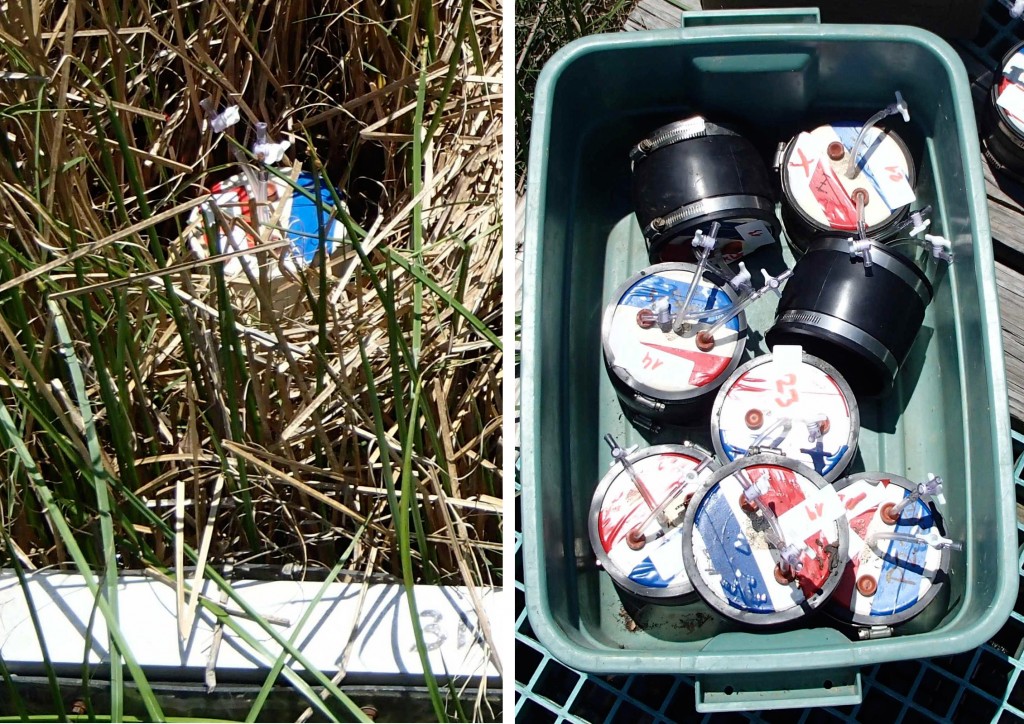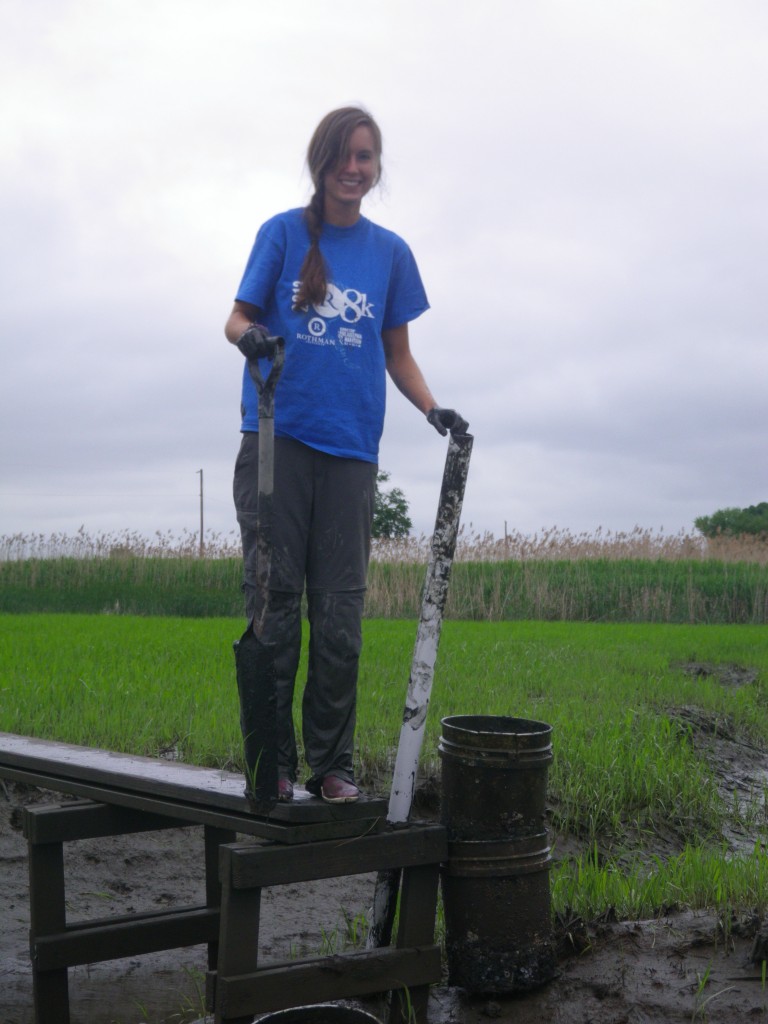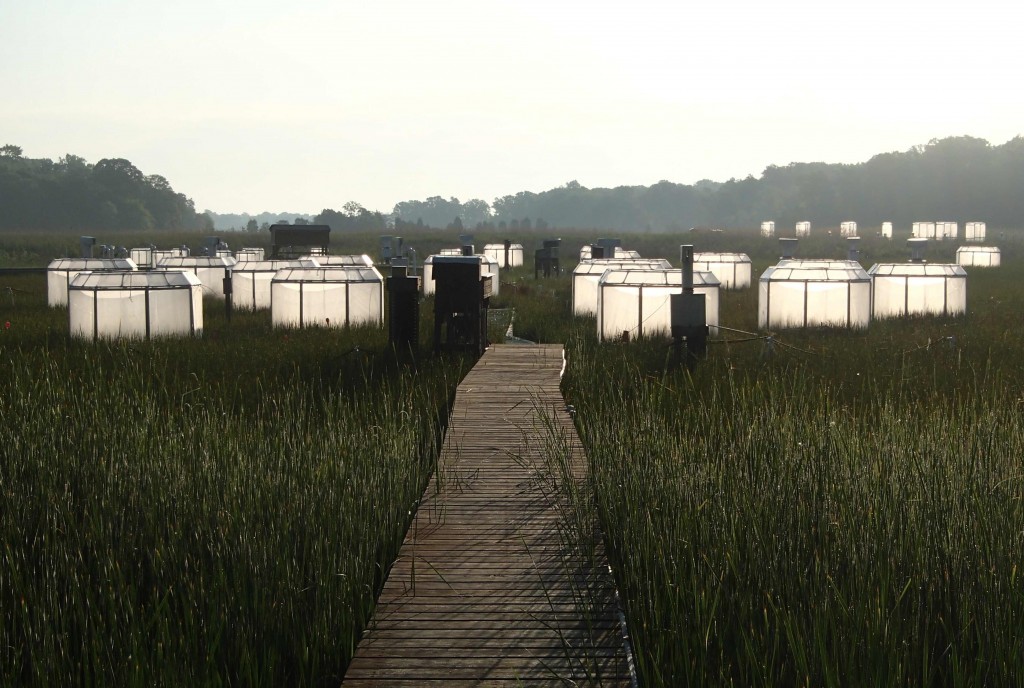by Melissa Pastore, biology graduate student at Villanova University
What if we could create a giant sponge capable of soaking up nitrogen pollution? It turns out that the Chesapeake Bay, which has experienced a rapid increase in nitrogen pollution from municipal and agricultural sources over the last few decades, already contains a natural version of this sponge: marshes fringing the Bay. But global change—and the nitrogen pollution itself—could change how this natural sponge operates.
The brackish marsh I use to study this filtering service, the Global Change Research Wetland (GCREW), sits in the Smithsonian Environmental Research Center in Maryland. It prevents a portion of nitrogen from reaching the Bay in two ways: (1) retention in plants and soil and (2) nitrogen-removing bacteria (denitrification). The marsh retains nitrogen when plants take it up through their roots to support growth and photosynthesis. When these plants die, some of their nitrogen is trapped in compounds too strong for bacteria to decompose and may remain in the soil for years. Denitrification, the second method of filtration, is different. Rather than trapping nitrogen, the marsh releases it to the atmosphere as gas. Think of denitrification as the way some bacteria are forced to breathe in waterlogged marsh soil. Without much oxygen around, denitrifying bacteria use a nitrogen-containing compound instead of oxygen, ultimately “exhaling” it out of the marsh as nitrogen-containing gases. The main gas produced (N2) is harmless and makes up 70 percent of our atmosphere. However, they can also produce nitrous oxide (N2O), a less common but more powerful greenhouse gas than carbon dioxide CO2.
I want to determine how rising CO2 and nitrogen pollution affect the three main fates of nitrogen in marshes (retention, denitrification and release to the Bay). At GCREW, my pollution sponge, I’m using large chambers featured in another Shorelines article that appear to have been dropped in the marsh by aliens, but actually provide a way to elevate CO2 in the air only for plants inside the chambers. Some chambers receive extra CO2, some extra nitrogen, some both, and others nothing. All are surrounded by biting black flies and defended by an army of (OK, one or two…) enormous spiders. After getting over my initial suspicion that aliens had been at work in the marsh, I began to develop my detective skills. Like any good detective, I started by figuring out which tools I would need to track nitrogen in the marsh. I decided to use the nitrogen isotope 15N (a nitrogen atom with an extra neutron). Adding an isotope to the natural pool of nitrogen in each plot is similar to adding a bright dye into your local pool. By following the particles of the “dye,” I can trace where nitrogen goes. This revealed an important clue: Some nitrogen wasn’t in the plants or soil. It couldn’t have simply disappeared, so I turned my thoughts to bacteria. Either the bacteria were “exhaling” nitrogen out of the marsh or aliens were truly intervening. To measure how much, if any, N2O escapes the marsh, I attached covers to pieces of PVC pipe in the marsh soil, allowing gas to accumulate within the cover. Between bIack fly attacks and with sweat burning my eyes, I took samples of the accumulated gas and measured the rate of N2O production within each chamber, ultimately proving my suspicion that bacteria (and not aliens) were guilty.

Left: PVC pipe in the soil with air-tight cover to accumulate gas. Right: Covers before being installed in the marsh plots. (Melissa Pastore)
The next step was to figure out how extra nitrogen pollution and CO2 could change the picture. So far, I’ve found that both have the potential to increase the marsh’s filtering ability, but in different ways. Elevated carbon dioxide causes the marsh to store more nitrogen belowground, and my preliminary data shows that storage belowground (in the roots and soil) may be more important than storage in the green stems aboveground. Because so much nitrogen is locked away, bacteria have less to use for denitrification, which means they produce less N2O. This is an interesting consequence, as the increase in one greenhouse gas (CO2) slows the increase in another greenhouse gas (N2O). While I do not advocate increasing CO2 levels for the sake of reducing N2O and increasing nitrogen storage, measurements show that CO2 is continuing to rise and we need to be aware of all future consequences. The negative consequences of rising CO2 outweigh the potentially positive effect on pollution in the Chesapeake Bay. Extra nitrogen, on the other hand, stimulates denitrification and nitrogen removal from the marsh as N2O. While this bacterial “breathing” may be good news for the Chesapeake Bay, it will also affect global greenhouse gas levels. Filtering nitrogen pollution is just one among several services marshes perform. Preserving these vital ecosystems as our world changes is not only in the best interest of species that live in the brackish marshes, but also the future of society. And so, like many field ecologists, I gratefully accept the sunburns, bug bites, scrapes and bruises of my work. These are my battle wounds in a war to gain knowledge, painfully earned in my quest to make a tangible difference in the world.



